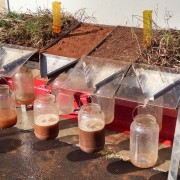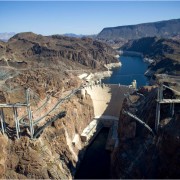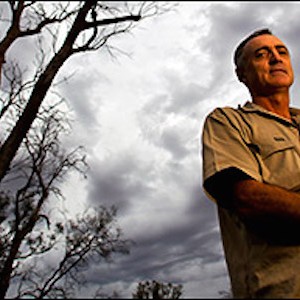Video: Greg Ogle Illustrates Murray’s Failing Circulatory System
Farmer turned conservationist, Greg Ogle explains how the healthy appearance of the Murray channel can be deceiving. He details the crucial importance of tributaries, lakes and wetlands to the river’s health.
With the Murray running as an irrigation channel, its circulatory system has become dangerously dry. According to Ogle, its lungs and heart will continue to suffer the consequences. Many of the most serious changes are yet to occur, he says. Ogle currently works as a regional manager for Australia’s oldest land trust, the Trust for Nature. He has lived in the area for nearly half a century.
Video by Aaron Jaffe, reach him at info@circlefofblue.org. For a complete list of credits, acknowledgements and other resources related to Circle of Blue’s coverage of “The Biggest Dry” please click here.











I think a more progressive process for regenerating the Murray-Darling sytem would result from a consultative approach with less tendency to argue and to Blame. The problems developing in the system are not, as many like to suggest, because of long-term general mismanagement but because of a specific failure to understand the long term variability in the catchment’s rainfall. The Bureau of Meteorology has published a 100 year annual average of the Murray-Darling Basin which clearly shows that at the beginning of the 20th century and for 30 years afterwards, the rainfall was below what we are experiencing now – so much for Global Warming’s effects. In the mid-century period (approximately 1940 to 1970) rainfall was very high and probably a lot of useful irrigation licences were then made available – I don’t actually know the dates when various allocations were made. However, since the seventies the average rainfall has declined but with no commensurate restriction on these licences to match the available water.
The interstate claims also appear to me to be totally without justification. To suggest that Queensland irrigators should be restricted in order to allow much larger distributions of water in NSW – just look at the relative areas involved in the catchment where Queensland’s share is miniscule compared with that of NSW – has no relationship to natural justice or fair distribution.
The allocation of irrigation supplies should surely be made against the actual rainfall runoff received in a given area and reduced by an amount required to provide a balanced flow in the river below to take it to the sea. i.e. Queensland’s water should not be allocated to NSW or Victoria or South Australia but to a fair contribution to the internal Murray-Darling system. Likewise, NSW should not have to provide water for states below. If NSW or Victoria were enjoyng large rainfall and Queensland in drought, should these southern states be asked (or even required) to provide pumped water for Queensland. A resounding no. This concept was clearly tested recently when Brisbane was very short of water while the Nortehrn Rivers of NSW were in flood. A suggestion that excess water from these rivers be provided for Brisbane by a pipeline to be installed was rejected outright by the NSW government and the local authorities involved. And rightly so. A farmer located in any area is dependent on the rain that falls on his/her property – not on the rain that falls on his neighbour’s property! He could build damns etc to harvest the water while allowing a small contribution to run off to sustain the lower river system but not necessarily to sustain other communities who receive their own share of rain to deal with in whatever way is necessary for them.
Lets get real in this debate. Reduce allocations across the board commensurate with the rainfall in that area of the allocation. If that were done without greed or rancour, in the same way, for instance as allocations from irrigation damns are restricted by the amount of water received or stored in a particular year, there would be no need for a Muuray-Darling rescue package. A known amount of water could flow to the sea every year, provided the rivers did not stop flowing as was the case in 1914 and in some earlier years in the mid to late 19th century. There is no mitigation programme which will counter the total lack of rain, but the pain should be shared equitably. Take a good look at the history of the system and act accordingly!
John Nicol